Ever fancied packing the fly rod for species like roach, rudd, perch and carp on a regular coarse fishing lake? There are countless “commercial” fisheries these days. This in itself is a bit of a lazy blanket term, I must say. There is quite a wide variety of such stillwaters, with the common denominators being abundant fish stocks, easy access and a simple pay on the day system.
Conspicuously, many trout lakes have turned into such coarse pools. A shame on one level, but you can see why it makes economical sense. Being a lot less brittle than trout, coarse fish not only bite better in hot weather but can easily be caught and released without going belly up. Six or seven quid a day is a lot kinder on the wallet than £20-£30, too.
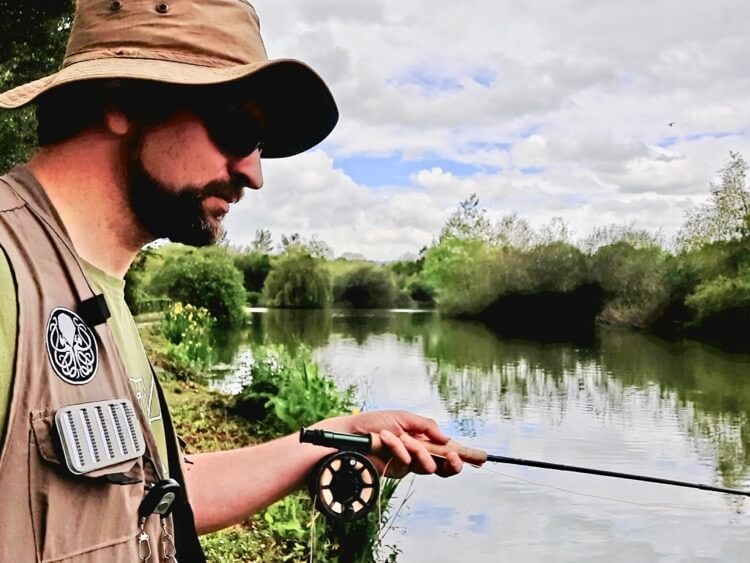
So what are we all waiting for? Are we honestly put off by a few silly comments? Fly fishing remains an underused way to fish these venues. Having fished many of them over the years, I’ve found most of them will respond well to fly fishing, especially from spring to late summer when insect hatches peak. But it does take a slightly different approach. So, where do we start?
Having just returned from a really enjoyable short session at Goodiford Mill Fishery, perhaps the best way is simply to describe the way I approached it. Indeed, I had several species in a quick afternoon hit following a coaching session I’d hosted. Nor did I need any exotic tackle or ninja like skills- far from it.
Obviously, there is only so much I can convey from a single blog, but hopefully what I’m about to relay will be helpful. So, while this should be a useful little exercise, my book Flyfishing for Coarse Fish, is still probably your best one-stop resource to get a broader understanding on this fascinating topic.
Is fly fishing allowed on coarse and carp fisheries?
Ok, so without further ado let’s address the first elephant in the room, permission and whether fly fishing is allowed. I get contacted about this a lot! The short answer is yes. Unless there are clear rules saying “no fly fishing”, I would assume it is allowed. Why the heck wouldn’t it be? Furthermore, if there’s no obvious barrier, why stress or make life complicated by emailing the owner with a load of questions that are likely to throw a spanner in the works (probably due to their limited understanding of fly fishing). Just get on and fish! As long as you debarb your flies and pack an unhooking mat, you’ll be fine.
If you are in more doubt, though, another good tip is always to ask in person, and never by digital means. A face to face conversation is far, far more likely to be positive. This way you can explain your approach and show that you’re a responsible angler. You should also, quite obviously, give others space and consideration, for example. I’ll never cast close to another angler and if it’s a popular spot a weekday might be your best bet.
You will, of course, have to adapt to the fishery and its rules and think on your feet. This part is more key to success than any set formula I can give you! Hence, on my last session, I tackled up at Goodiford Mill Fishery with an open mind, fully expecting to have to explore and experiment a bit. Looking at the rules, I wouldn’t be able to use dry fly (“no surface fishing”). I would also have to give others space and pick my spots with care- a quick walkaround revealed both tight corners (get your roll cast ready!) and more open spots to launch a longer line.
What would a typical fly fishing set-up look like for carp, roach, perch etc?
Knowing that the biggest “match” lake has lots of roach and rudd and smaller carp, I headed here with an 8’ 6” 4 weight outfit. Fun for the little stuff, but fine for modest carp, too. If I was tackling a natural venue with overgrown banks, I’d have perhaps packed a 10 footer for extra reach. Had I only had eyes for carp, or perhaps the fishery had a reputation for big, bruising fish, I would have been stepping up to a tougher outfit, such as a seven or eight weight with 8lb leader. On this occasion, however, I wanted a mix of species- so fishing lighter was chosen to give better sport and more bites.

I used a simple set up of 6lb main leader to low diameter 4.4lb line (or 0.14mm) for tippet. Now, you can go very short to detect bites – as little as 3-4ft can be ideal, so that every bump shows up on the end of the fly line. But I tend to prefer to use a longer leader, so that the fly line is further away from the flies and not splatting down on the fish.
Bite indication is quite simple. With lighter wet flies, you could simply apply floatant to all but the last 2-3ft of the leader and watch for it zipping away when a fish takes. Easier still, though, is to attach a tiny strike indicator. The stick on kind is simple enough. A minority of Hogwarts style purists hate them, yes, but they’re blooming useful- and whatever you’re watching, whether it’s a greased bit of leader or the end of the fly line, all these things are serving as “bite indicators”. Feel free to use ESP to detect takes if it makes you feel like a superior mortal! It goes without saying that if you spot takes in plain sight, you can just take the indicator off.
Anyhow, back to some of the details. On this occasion I went for about 7.5 feet of leader in total. This consists of 4 feet of standard 6lb mono line, followed by a lighter tippet section of 4.4lb low diameter copolymer tippet. The lighter section will carry two tiny flies to start with, spaced only 18” apart, with a tiny strike indicator attached where the different line thicknesses join (the knot will keep it snugly in place- although I can move it if, say, I think the fish are deeper).
While we’re here, another question people ask: Why fish as light as a four weight? Simple- the heavier the fly line, the more fish you’ll scare. Carp not so much, but with rudd sipping down buzzers, a light fly line such as a three or four will settle like a feather compared to a seven or eight. It will also bend beautifully when you hook a fish- and I want to enjoy every one of them.
What flies should I use for coarse fish? Do I need to copy bait or will I find insect hatches?
This question is wide open. There are endless flies you can try. I’m always trying to nudge people towards imitating real insects, but sure, you could also copy bread or maggots or whatever the regulars are using. I have nothing against this. It works, it can be fun and I don’t want to be the “natural fly only” snob who shoots people down who just want to have some fun.
But, and this is a big but…. how do I put this? It’s just not as challenging, fun or rewarding as using more imitative flies, in my opinion. The whole reason we are fly fishing is not to catch a huge weight of fish, but to enjoy the art of trickery. And while “maggot flies” or whatever might be a useful gateway drug, you don’t want to use them as a crutch when starting out. The only way to get confidence with more authentic flies and more convincing insect imitations is to get on the natural stuff!
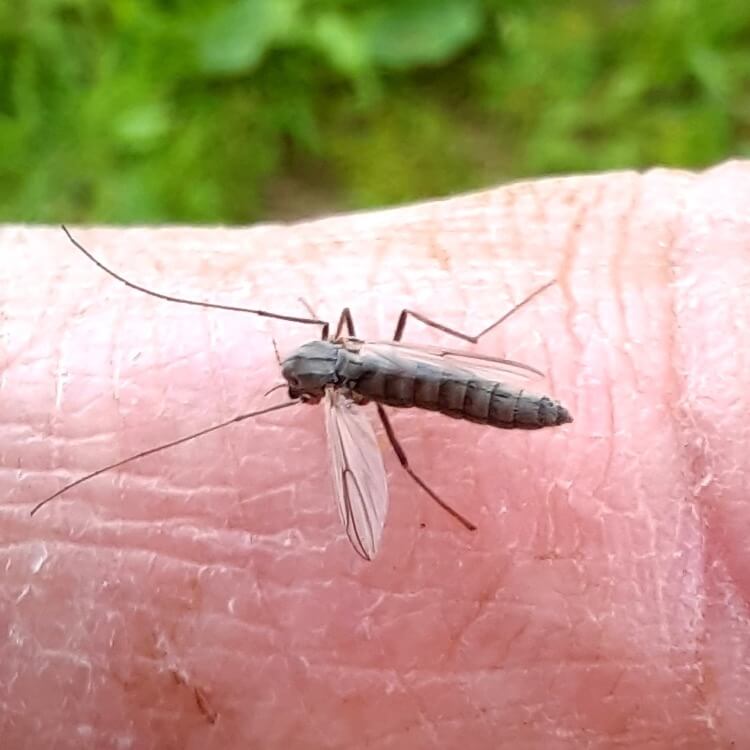
Nor is even the muddiest manmade lake devoid of fly life. On my visit to Goodiford I saw several mayflies, not to mention hordes of small black buzzers. The latter were in their thousands by mid afternoon and the fish were definitely on them. Few were sipped off the top, but you could see swirls in the water in the areas where they were concentrated. More on this shortly…

If you don’t tie your own flies, my shop has some selections to get you started. This side of the sport is well worth experimenting with, it must be said, as “rolling your own” very satisfying and a great way to learn and adapt to your local waters.
Curious eyes and itchy feet
Beyond any talk of tackle, flies or leaders, the most important rule for any session is to be mobile and adaptable. You will only get the best from any venue by walking the banks and watching closely. This often means not casting out at all, but just looking and using your feet.
On my session, I couldn’t resist a few casts right where my learners from the morning had been throwing in maggots. So shoot me! This isn’t “true” imitative fly fishing, but I was curious to see what would happen. Quite quickly I got some twitchy takes, but these were fiendishly hard to connect with. A couple of small perch are the sum total after ten minutes or so, but were already telling me a few things.
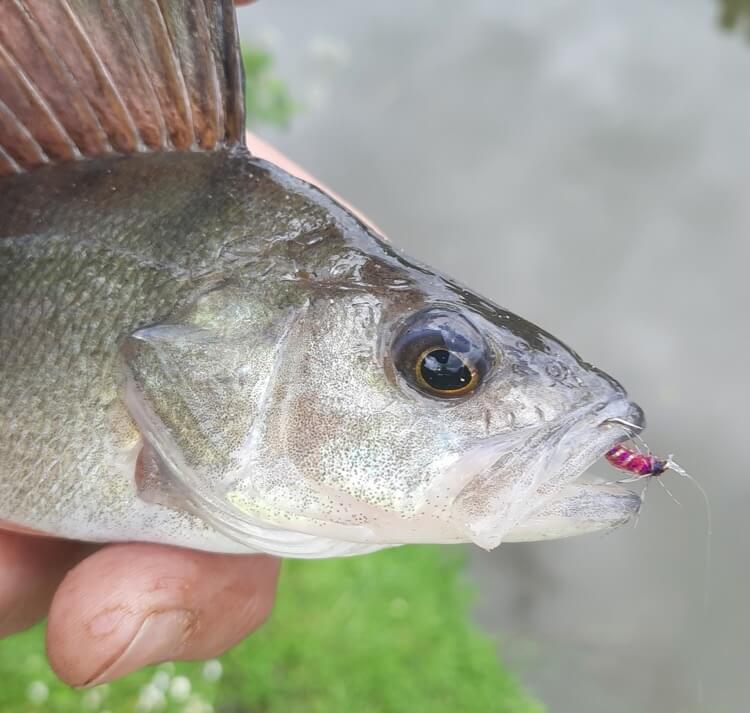
First up, it was a small, brightly dubbed spider they seemed to want, rather than a smaller, sparser black one. For the record, I use spiders a heck of a lot for catching coarse fish. These flies are so quick and simple to tie and yet so convincing to fish! I also think that the soft materials encourage shy biting fish to hang on for longer than modern nymphs like epoxy buzzers (although those also work!). I tie mine in various colours. The classic Black and Peacock is a killer. I also tie special slow sinkers in lighter colours, and even some using bright sparkle dubbing (Hemingway’s UV is my favourite) and mix up my hackles- hen, partridge, starling, woodcock, you can’t go wrong with any of the classics. Like a quality pilsner, even the fussiest spider seldom has more than four ingredients.
The takes then came quite quickly, but were lightning quick. This is a lesson in itself: don’t expect fish like roach and rudd to hook themselves! Their bites are often rapid and less aggressive than trout. I missed a hatful of quickfire bites, before a better fish took hold properly. It was a gorgeous roach of 4-6oz, which put quite an impressive bend in my four weight.
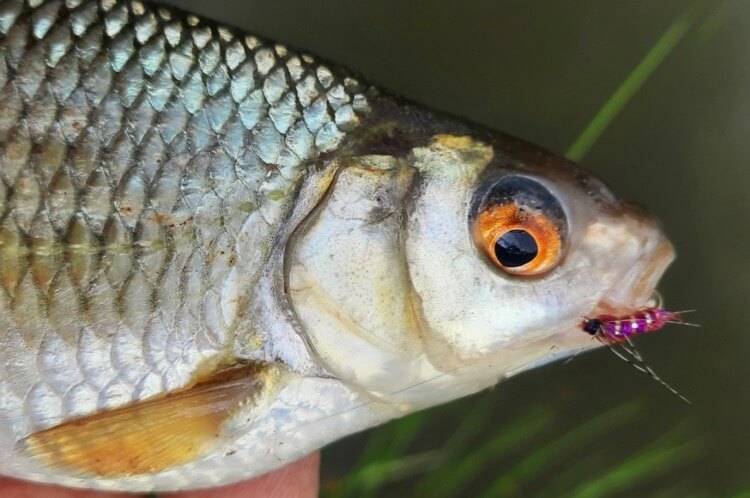
Action then slowed, until I tried a simple trick to get the fish back- and that was to “kiss” the water two or three times with my flies each time before making the final “proper” final cast. This unashamedly mimics a bit of bait being thrown in- and makes fish come in to investigate. All you need to do is“plip” the water a few times before letting your flies sink. It really works and you don’t need any feed to bring the fish in.
Perch were the next species to arrive, with two of the greedy things grabbing the fly. Again, it was a colourful spider they wanted (a simple bright claret bodied model in a 16, with a partridge hackle) perhaps owing to some murkiness in the water. Shortly after, however, the fish were soon losing interest and it was time for a walk.
Buzzers galore!
After a couple of quick goes in swims that didn’t produce (I’ll often spend only 5 minutes in each), I then found a sunny spot round the corner on the main match lake that looked perfect. Peering around with my polarised glasses on, there were fish under floating bits of reed and flotsam. Weirdly, this makes me think of a Pacific Ocean scene, where fish flock to bits of debris- well this is the same concept in miniature.
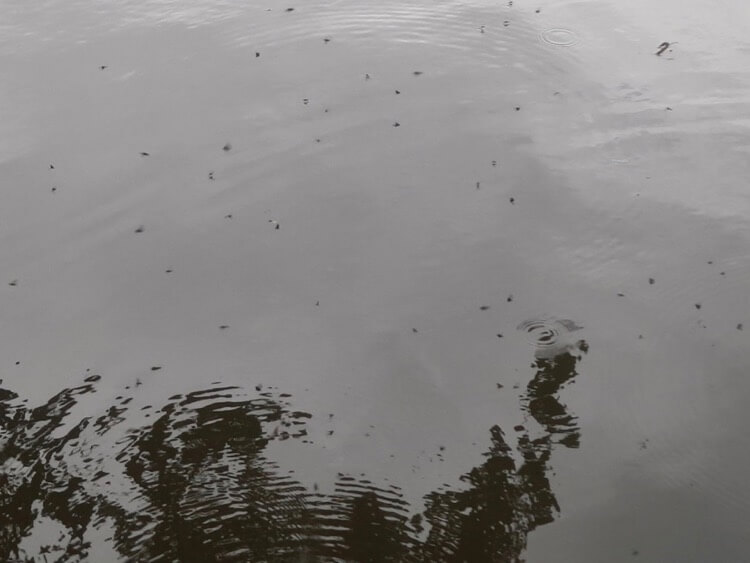
Even better, though, was a hatch taking place a few yards further. Had I just started fishing by the car park, I’d never have found this action- but just where the breeze created a bit of a collection point, there are scores of insects on the water. Don’t let anyone tell you that manmade lakes have no fly life- even the muddiest are rich in buzzers and hatches will be daily. Easy pickings on the way?

Strangely, the initial answer was no. Looking at the insects hatching, I suspected my flies might be a bit large. It wasn’t until I went down to a single, tiny size 18 Black Holo Spider that the fish responded. Three roach and a tiny rudd came in quick succession. I also cursed my reflexes as I managed to miss what looked to be a half-pound plus golden rudd. Or even a crucian? I will never know.
Another point worth making here is on retrieves. More often than not, my method is to gently land the flies and then NOT RETRIEVE. AT ALL! I’ll only offer the occasional draw or pluck to get the fly into a better position or try and draw a reaction. Most often though, I’m casting very regularly and watching for a quick reaction.
What I’m never doing is casting out and leaving the flies for ages. You can indeed fish them deeper and try lifting and dropping every few seconds- but we’re never “float fishing”. Actually I hate these snobby sounding binaries in angling! Any decent float fisherman is constantly working his bait and tinkering with presentation! Nor are we fishing for trout here- and if you find yourself constantly retrieving flies the chances are you’re doing it wrong (unless, of course, you’re fishing a streamer type fly for predators). This is important to note.
Many takes were missed, and the fish needed a rapid strike at any twitch on the leader or indicator, but sport was great for a bit. This is the trouble with fly fishing. It’s addictive and time really runs away from you! I could have spent a small eternity going for these silver fish, but by this stage I’d also seen some carp and really fancied hooking one.
Fly fishing for carp
While floating flies or baits are banned at Goodiford Mill, I fancied a crack with a slow sinking wet fly. In the summer this is often my go to method for carp. Nor do you need fake pellets or bread- although an egg fly can be a good way to put a bend in the rod.
Just out of interest, I tried the tiny spider for a bit, but it wasn’t turning any heads. A switch to a bigger fly with a slightly faster sink rate made sense. Indeed, while I like a delicate, slow sinking wet fly for slow moving or sunbathing carp, there are other times when one that makes a little “plop” will arouse ther curiosity. On went a size 14 Beaded Black and Peacock with an orange tag- and this time, just a single fly.
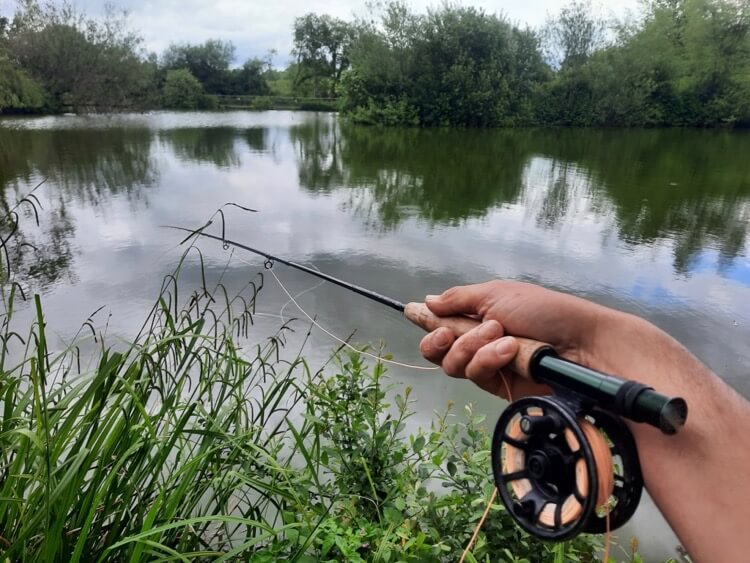
The next two fish were fluffed up! The first just wasn’t interested- it was moving too fast and not feeding. The next was more catchable, I suspect, but I landed the fly too close to it. The art with these fish is to land the fly into their path so that they’re aware it has touched down, but not right on their heads. It takes practice- and you also have to be mindful of how fast your fly sinks and how fast the fish is moving.
Third time lucky? The next fish I spotted was a curious, orangey-gold mirror carp. On my first shot, I saw it turn and approach the fly, but the spider sank out of view before it could collect. The very next cast, however, I managed to get the fly about two feet ahead of the fish. I didn’t retrieve, but just watched. I couldn’t see the actual fly, but witnessing a sudden gobble of lips I knew it had been taken- and so I struck and the fish was properly hooked.
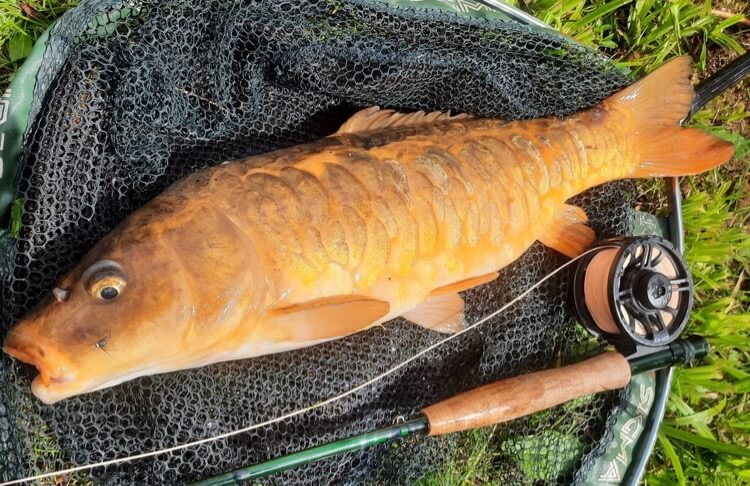
It was a lovely few moments of excitement, especially as I could also hear the tone of conversation among the carpy boys on the other bank changing from “what’s that nutjob doing?” to “that looks fun”. Even at only four or five pounds, the fish took me almost to the backing! On light tackle, I simply let it rip away into open water. It gave a superb account of itself- and couldn’t be rushed on 4.4lb tippet. This is another good reason to use a light, soft actioned rod for all-round fishing. A blank in the two to five weight class will bend a heck of a lot, giving you a bit more leeway with light tippets.
Finishing off
To complete the session, I then had another stroll to try one or two final swims. Quite often, the corner pegs and anywhere with bankside vegetation are good on coarse fisheries. Indeed, anywhere such as back channels, trees and reed margins are stopping or passing points for fish, while any corner of a lake where the wind is blowing into will tend to concentrate food and fly hatches.
The other advantage of shallower margins is that you can often see signs of fish by way of swirls or finning patterns. A gently sinking wet fly such as a bloodworm is ideal for this, or you could take a look at some of the patterns our American and European friends use! No futher carp to finish my session on this time, unfortunately, with just one small and greedy perch to round things off.
Overall, though, this was a great little session to get some bites and a welcome bend in the rod, which is what it’s all about, and all in the space of less than three hours. With the exception of the area where I found the tiny buzzers hatching, I doubt I spent more than ten minutes in any one swim. But by changing flies and spots regularly, and keeping my eyes peeled, there were opportunities to grasp and four species in total, if we count the world’s smallest rudd.
Of course, this is just one session and one example of quite a big subject, but I hope this post has been helpful. For more on all aspects of tackling coarse species on the fly, do check out the book, my other blog posts and there also several useful blow-by-blow sessions on the Turrall Flies website– and Turrall also produce various flies and fly selections for coarse species, whether that means roach, rudd, dace, chub, perch, carp or pike. For anyone in Devon and Somerset this season, whether you’re local or a visitor, I also offer guided fly fishing sessions on many kinds of venues.
Until next time, take care and take aim where others fear to fly! It’s bloody good fun and the jokes will soon dry up when they see the bend in that rod.


